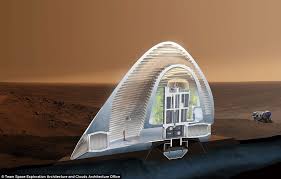Washington, Dec 30: The first explorers on Mars may build their homes using the ice beneath their feet to effectively protect them from the harsh martian environment and provide a safe place to call home, NASA scientists say.
 When astronauts set foot on Mars, they may stay for months rather than days as they did during Apollo missions to the Moon.
When astronauts set foot on Mars, they may stay for months rather than days as they did during Apollo missions to the Moon.
The surface of Mars has extreme temperatures and the atmosphere does not provide adequate protection from high-energy radiation, NASA said.
These explorers will need shelters to effectively protect them from the harsh Martian environment and provide a safe place to call home.
According to researchers at NASA's Langley Research Centre in Virginia, the best building material for a new home on Mars may lie in an unexpected material: ice.
"Mars Ice Dome," is one of many potential concepts for sustainable habitation on the red planet in support of the agency's journey to Mars, NASA researchers said.
"After a day dedicated to identifying needs, goals and constraints we rapidly assessed many crazy, out of the box ideas and finally converged on the current Ice Home design, which provides a sound engineering solution," said Kevin Vipavetz, Langley senior systems engineer.
The "Mars Ice Home" is a large inflatable torus, a shape similar to an inner tube, that is surrounded by a shell of water ice.
The Mars Ice Home design has several advantages that make it an appealing concept, according to NASA. It is lightweight and can be transported and deployed with simple robotics, then filled with water before the crew arrives.
It incorporates materials extracted from Mars and because water in the Ice Home could potentially be converted to rocket fuel for the Mars Ascent Vehicle, the structure itself doubles as a storage tank that can be refilled for the next crew.
Another critical benefit is that water, a hydrogen-rich material, is an excellent shielding material for galactic cosmic rays – and many areas of Mars have abundant water ice just below the surface.
Galactic cosmic rays are one of the biggest risks of long stays on Mars. This high-energy radiation can pass right through the skin, damaging cells or DNA along the way that can mean an increased risk for cancer later in life or, at its worst, acute radiation sickness.
Space radiation is also a significant challenge for those designing potential Mars outposts. For example, one approach would envision habitats buried underneath the Martian surface to provide radiation shielding.
However, burying the habitats before the crews arrive would require heavy robotic equipment that would need to be transported from Earth.





Comments
Hello,
I am writing from Space Exploration Architecture '?we are the team who designed Mars Ice House, the winner of NASA's Centennial Challenge for a 3D-Printed Habitat on Mars.
I noticed you posted a great article earlier this month about our project, Mars Ice Home. Could you please credit our project in your article by including a reference back to our website?
Here is the link: http://www.spacexarch.com/mars-ice-home/
Kind Regards,
Demetrio Rothenhausler
Add new comment